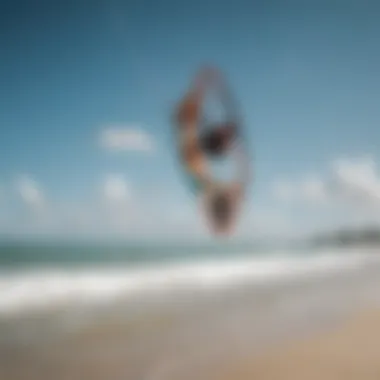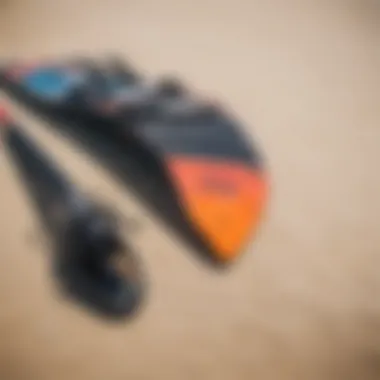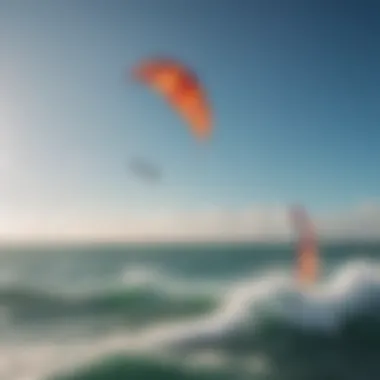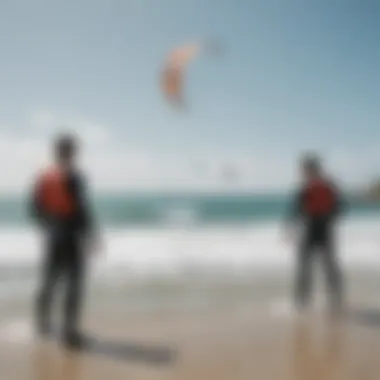Kite Surfing Lessons in Fort Lauderdale: Explore Your Passion


Intro
In the heart of sunny Fort Lauderdale, kite surfing offers a thrilling adventure that combines both skill and freedom. This delightful coastal city, hugged by the Atlantic waters, provides an ideal backdrop for both novice and experienced kiteboarders. As you delve into the sport, it's important to understand the foundations of gear selection and skill development. Let’s embark on a detailed exploration of what it takes to navigate the waves and seize the wind.
Gear Selection
When it comes to kite surfing, the right equipment plays a crucial role. Picking the right gear not only enhances your performance but also boosts your confidence on the water.
Types of Kites
Kites are the backbone of this exhilarating sport, and they come in two primary styles:
- Inflatable Kites: These are the most common type found in Fort Lauderdale. They are durable and offer excellent power for jumping and tricks. A good choice for those looking to tackle various conditions.
- Foil Kites: These are perfect for lighter winds. They have a unique design and can be quite fast, appealing to those who want to carve through the water with finesse.
Choosing the right kite depends on your skill level and the prevailing conditions on any given day. The local shops often provide guidance on the best options available, tailored to Fort Lauderdale’s unique weather patterns.
Choosing the Right Board
Equally important is the kiteboard itself. Several factors contribute to finding the right board:
- Size: Generally, larger boards are more stable and better for light winds, while smaller boards are ideal for speed and tricks.
- Shape: The board’s shape affects how it interacts with the water. Some boards are designed to glide through the water more smoothly, while others focus on performance in choppy conditions.
- Foot Straps vs. Bindings: Depending on your style, you may prefer foot straps that offer quick adjustments or bindings that provide more control during jumps.
Skill Development
Once you've got your gear sorted, it’s time to dive into some essential techniques. Developing your kite surfing skills is a journey, not a race.
Essential Techniques
Here are fundamental skills every kiteboarder should focus on:
- Kite Control: It’s crucial to understand how to maneuver your kite in the wind, adjusting its position to maintain balance and power.
- Body Positioning: Your posture on the board can greatly influence your ride. A low stance helps with stability, especially during gusts.
Progression Tips
As you embody these techniques, consider these tips for skill enhancement:
- Start with Lessons: Enrolling in classes with certified instructors ensures that you learn the right way from the get-go. Local schools in Fort Lauderdale often tailor their teachings to accommodate different skill levels.
- Practice Regularly: Like any other sport, the more you ride, the better you'll become. Paul Upit from the Fort Lauderdale Paddleboarding Club suggests hitting the water as often as possible.
- Stay Informed: Connect with the local kiteboarding community through forums like Reddit or Facebook. It’s a great way to keep up with insights and share experiences.
"Kite surfing isn’t just a sport; it’s a lifestyle. Mastery comes with time and community." - Local Instructor
Foreword to Kite Surfing
Kite surfing, often referred to as kiteboarding, is an exhilarating water sport that combines aspects of surfing, wakeboarding, and paragliding. It’s not just about skimming across the water; it’s a dance with the wind as the kite soars high above, propelled by adrenaline and skill. In this article, we will explore every aspect of kite surfing in Fort Lauderdale, a paradise for both eager learners and seasoned enthusiasts. Understanding the fundamentals of kite surfing sets the stage for a thrilling adventure, allowing practitioners to connect with nature in a uniquely engaging way.
Understanding the Basics
At its core, kite surfing involves riding a small board while being pulled by a large, controllable kite. This sport’s beauty lies in its simplicity—yet, it’s the nuances that can make or break a session on the water. First, practitioners must grasp how to control the kite through wind direction and intensity. Each kite has its unique handling characteristics, and learning to pilot one can feel like steering a vessel through a gusty sea.
Beginner lessons focus on understanding wind windows, which is crucial for launching and landing the kite safely. Kite surfers often spend time on land practicing control before they ever touch the water. Local schools in Fort Lauderdale generally provide lessons that cater to various skill levels, introducing key concepts step by step. The learning curve can seem steep, but patience is essential; mastery develops over time, accompanied by many joyous moments riding the waves.
The Allure of Kite Surfing
What draws individuals to kite surfing? The answer often lies in the intersection of thrill and tranquility. Picture this—gliding across the turquoise waters of Fort Lauderdale under endless blue skies, feeling the rush of wind as your kite dances above you. For many, kite surfing is not merely a sport; it's a form of expression and a means of escape from the everyday grind.
The community surrounding kite surfing adds another layer to its appeal. Local meet-ups, events, and competitions create an atmosphere that fosters both camaraderie and competition. For newbies, connecting with experienced kite surfers often leads to invaluable tips and shared experiences. As they say, "It takes a village, or in this case, a beach!" Plus, Fort Lauderdale’s stunning coastline offers the perfect backdrop for both learning and showcasing skills.
With all these elements combined, kite surfing in Fort Lauderdale becomes not just an activity but a lifestyle. The hope is to spark an interest that motivates more people to give this impressive sport a try.
Kite Surfing in Fort Lauderdale
Kite surfing in Fort Lauderdale is not merely a pastime; it embodies a vibrant lifestyle deeply interwoven with the region’s coastal identity. The sport leverages the city’s breathtaking shores, warm climate, and consistent winds, making it a prime spot for both beginners looking to catch their first wave and seasoned veterans aiming to refine their skills. This locale provides a perfect backdrop for learning, thriving on the synergy of nature and adventure. Understanding the kite surfing scene here is essential for anyone interested in mastering this exhilarating sport.
Overview of Fort Lauderdale's Kite Surfing Scene
The kite surfing scene in Fort Lauderdale has gained momentum over the years. Windsurfers, surfers, and lake enthusiasts alike flock to this city, intrigued by the promise of adventure that kite surfing offers. Multiple kiteboarding schools dot the shoreline, each bringing unique teaching styles, equipment, and community spirit to the table. Local instructors, oftentimes ex-competitors or passionate riders themselves, have an impressive grasp of both techniques and safety essentials.
The community surrounding kite surfing here is welcoming, fostering a sense of camaraderie among participants. It’s common to see groups congregating on the beach, sharing tips or spectating as a fellow kite lover takes to the waters. The array of skill levels—from shaky beginners to acrobatic pros—creates a dynamic environment that encourages growth.
With organized events, like local competitions and gatherings, this network not only supports learning but also enriches the overall experience of the sport. Overall, Fort Lauderdale’s kite surfing spirit is electric, an inviting mix of challenge and recreation set against the stunning backdrop of ocean waves.


Best Locations for Kite Surfing
Finding the right spot can make all the difference in kite surfing. Fort Lauderdale offers various locations tailored to different skill sets and wind conditions. Here are some top picks:
- Hugh Taylor Birch State Park: A sheltered bay ideal for beginners, this location’s shallow waters make it safer for learning.
- Fort Lauderdale Beach: Known for its vibrant atmosphere, this beach caters to all levels of kite surfers, with ample space and beautiful scenery.
- Lauderdale-by-the-Sea: Slightly less crowded, this spot offers more open water and can be ideal for those looking to practice tricks without much fuss.
- Pompano Beach: A favorite of advanced riders, the waves here provide a perfect playground for those looking to push themselves.
- A1A Park: With consistent winds, this park is popular among local kite surfers ready to test their mettle.
With such a variety of choices, from tranquil parks to lively beaches, everyone can find their niche.
Kite surfing in Fort Lauderdale isn’t just an activity; it’s a way to connect with nature and other enthusiasts.
Choosing the Right Kite Surfing School
Selecting the right school for kite surfing is like picking the right bait for fishing; it can make all the difference in landing a catch. The right kite surfing school not only provides you with the technical skills needed to ride the waves but also enhances your enjoyment of this thrilling sport. There's a lot to sift through when evaluating schools, from instructors to reviews, and even lesson types—it can feel overwhelming at times. But fear not! Let’s break it down so you can make an informed choice.
Factors to Consider
Reputation and Reviews
When diving into the sea of haystack schools, reputation can be a shiny needle that guides you. Check online reviews on platforms like Facebook and Reddit to learn what former students are saying. A school with a good standing often signals qualified teaching and robust support for their students.
The crucial characteristic here is consistency. Consistent positive feedback about the professionalism and effectiveness of instructors is key. A reputable school inspires trust and is likely to offer a safer learning environment. Remember, not all reviews are equal. Watch out for those unique experiences, as they can provide particular insights—both pros and cons—about any school.
A school’s standing reflects its commitment to outstanding teaching and students' safety, which are essential in kite surfing.
Qualified Instructors
Here’s something to chew on: your instructor can make or break your experience. Qualified instructors are pivotal in ensuring you gain the skills necessary to navigate the waters with confidence. Look for individuals who hold certifications from respected kiteboarding organizations. Their experience and knowledge help tailor the learning process to fit your needs.
Instructors who care about your progress and safety will gauge your comfort level and adjust their guidance accordingly. Selecting a school that boasts instructors with solid credentials—not just sailing titles—will set a sturdy foundation. Plus, with experienced teachers, you often get access to a wealth of tips that can accelerate your learning.
Student-to-Teacher Ratios
Think of student-to-teacher ratios like farmers tending to crops—the more hands on deck, the better the care. A lower ratio means each student gets more personalized attention, increasing the chances of mastering skills quicker. Ideally, a ratio of 2:1 or 3:1 ensures you won’t be lost in the crowd and can ask necessary questions without hesitation.
A school with a favorable student-teacher ratio can create an environment where you feel comfortable asking questions and receiving tailored feedback. This single factor can significantly influence your success and enjoyment while learning kite surfing.
Types of Lessons Offered
Private Lessons
Private lessons are like a bespoke suit. They fit your unique learning style and needs. This setting can be particularly beneficial for beginners who may feel anxious in group scenarios. You get one-on-one instruction, which means you can progress at your own pace.
Additionally, tailored lessons allow for focused feedback and a chance to master skills without distraction. However, they can be pricier than other options, so budgeting is essential if you're leaning this way.
Group Lessons
Group lessons can resemble a lively team-building retreat. They offer social interaction and a sense of community, making it easier for many to feel engaged and motivated. Learning with others means you can share tips, strategies, and even stories about your experiences on the water.
The downside? Sometimes, the attention can get diluted among multiple students. This structure can also lead to pacing issues—while one student may be ready to advance, another may still be grappling with basics. Ensuring you find a school that limits group sizes can mitigate this.
Combination Courses
Combination courses are like a buffet where you can sample various dishes. These classes offer flexibility as they often blend private and group lessons, allowing you to experience the benefits of both. They are especially useful for those who want to dip their toes into different teaching styles before committing fully.
However, the challenge lies in choosing a school that effectively integrates these lessons without compromising quality. Ensuring that instructors are aware of your individual goals will help maximize this approach.
The Learning Process
Understanding the learning process in kite surfing is crucial for anyone looking to master this exhilarating sport. It serves as the backbone of skill development, ensuring that learners not only grasp the basic techniques but also progress to advanced maneuvers with confidence. The beauty of kite surfing lies in its blend of physicality, strategy, and creativity, making a solid understanding of the learning process vital for maximizing enjoyment and safety on the water.
Fundamental Techniques
Wind and Water Awareness
Wind and water awareness is the foundation of kite surfing. This unique aspect involves understanding how wind patterns and water conditions interact, which is essential for effective kite control and riding. Realizing how winds shift throughout the day and learning to read the water’s surface can significantly enhance one’s performance and safety.
The key characteristic of wind and water awareness is the need for constant observation and adaptability. A kite surfer who is keenly aware of environmental changes will find themselves responding swiftly to potential hazards or alterations in their riding conditions. This aspect is immensely beneficial for learners because it cultivates their intuition regarding kite surfing dynamics.
One unique feature of this technique is the varying effects that different weather situations have on both wind and water behavior. On a calm day, the water may appear placid, but hidden currents may lurk beneath. Being cognizant of these factors allows kite surfers to make informed decisions about when to go out and when to hang back, preventing accidents and ensuring enjoyable sessions.


Kite Control
Kite control is arguably one of the most critical skills for any kite surfer. It involves managing the power and position of the kite in relation to the wind and the rider's movements. Learning to harness and modulate the power of the kite is central to navigating the water effectively.
A standout characteristic of kite control is the relationship it establishes between the rider and the kite. When a rider manages the kite skillfully, they can execute jumps, turns, and transitions easily. This ability to manipulate the kite enhances the overall experience and brings a sense of freedom and mastery.
Kite control also comes with its set of challenges, particularly for beginners who may struggle with the kite’s responsiveness. For instance, overreacting to minor wind changes can lead to uncontrolled movements, resulting in falls or accidents. Thus, developing kite control involves practice, patience, and, sometimes, a bit of trial and error.
Boarding Skills
Boarding skills come into play once the kite control is somewhat mastered. This refers to the ability to stand up on the board and ride smoothly, integrating the kite’s power effectively into forward motion. It is about achieving balance and coordination while riding the waves, which can be demanding for new kite surfers.
One key element of boarding skills is stance. A proper stance allows for better weight distribution on the board, which is vital for maintaining speed and managing tricky maneuvers. This aspect makes learning boarding skills imperative, as it lays the groundwork for performers looking to progress further.
The unique feature of boarding skills lies in the combination of muscle memory and timing. Riders must develop a rhythm that syncs their movements with the kite's pull and the sea’s dynamics. Gains in this area can lead to rapid improvement in riding techniques, though it can also be frustrating for beginners who feel unsteady on the board at first.
Progression from Beginner to Advanced
The journey from a novice kite surfer to an advanced one involves a series of progressive steps that build on the foundational skills mentioned above. Initially, students focus on basic kite control and wind awareness, which allows them to become comfortable in the water without overwhelming them. As skills develop, they can experiment with various tricks and maneuvers, increasing their confidence.
Each stage of learning is essential for promoting gradual confidence and proficiency. It’s common for learners to hit walls or experience frustrating days, but persistence is key. Over time, many find that as they conquer previous challenges, they are ready to take on more advanced skills and techniques. Riders may begin mastering jumps and tricks, gaining a sense of accomplishment and joy that keeps them coming back to the water.
Ultimately, the learning process in kite surfing creates a dynamic environment where practice and community support foster continuous skill development. By engaging deeply with the fundamental techniques and embracing the journey of progression, riders not only enhance their abilities but also deepen their love for this thrilling sport.
Essential Equipment for Kite Surfing
When it comes to kite surfing, having the right equipment isn’t just important; it can mean the difference between a thrilling ride and a frustrating experience. Good gear enhances your performance on the water, promotes safety, and provides comfort during your lessons. Understanding how to choose the right kites, boards, and safety gear is essential for anyone eager to dive into this sport.
Kites and Boards
Differences in Equipment
The world of kite surfing encompasses a variety of kites and boards, each designed for specific conditions and skill levels. Kites differ mainly in size, shape, and type, which can greatly affect how they perform in varying wind conditions. For instance, a larger kite catches more wind and can generate more power, making it ideal for lighter wind days. Conversely, smaller kites are more suited for high winds, allowing for quicker turns and better control.
"Choosing the right kite for the right conditions makes all the difference in your kiteboarding experience."
Boards, on the other hand, showcase their own diversity in terms of size and shape. Directional boards are designed for riding in one direction, while twin-tips allow for riding either way. This flexibility is a huge perk for beginners learning the ropes, as it lets them focus on their skills without worrying about their board orientation. Each type certainly has its pros and cons based on the environment and rider ability.
Choosing the Right Size
Selecting the correct size of kite and board is not just a matter of preference, it directly impacts your performance and safety. A kite that is too large for a rider can be difficult to control, especially in high winds, leading to potential accidents. Conversely, if the kite is too small, it may not generate enough power to facilitate lift and fluid motion on the water.
When choosing the right size, most instructors will assess the rider's weight, skill level, and local weather conditions. A good guideline is that larger riders generally require larger kites, whereas lighter individuals can manage with smaller ones.
This personalized approach aids immensely in creating an enjoyable learning atmosphere. Getting it right from the start allows beginners to build confidence quickly.
Safety Gear
Impact Vests
A key element of kite surfing equipment often overlooked is the impact vest. This gear plays a vital role in protecting the rider during falls and mishaps. With inflatable padding, impact vests cushion the blow on hitting the water, significantly minimizing the chance of injuries.
These vests are not just about safety; they're also designed with comfort in mind, enabling movement without excessive bulk.
Helmets
Helmets in kite surfing are often seen as essential for beginner and advanced riders alike. They help prevent head injuries from falls, collisions with the board, or unforeseen accidents caused by strong winds. Riders should seek helmets that are lightweight yet sturdy, with a good fit to ensure comfort while allowing full concentration on the ride.
Additional features like adjustable straps and breathable materials can enhance the experience by providing better ventilation and a secure fit.
Safety Leashes
Last but not least, safety leashes serve a crucial purpose in kite surfing. They keep the kite attached to the rider, which is key during adverse conditions or if the rider loses control. A good quality safety leash offers an important peace of mind, allowing riders to detach safely from the board if the situation calls for it.
These leashes come in various designs, some with quick release features that can be life-saving in case of emergencies. Choosing a reliable safety leash is a small investment for a significant return in safety and security on the water.
Safety Considerations
The significance of safety in kite surfing cannot be overstated. Without a firm grasp on safety protocols, even the most exhilarating sessions can turn into a potential disaster. Kite surfing combines wind, water, and a fair amount of equipment, making awareness and preparation key for an enjoyable experience. Ensuring safety not only protects the individual rider but also those around them. Like they say, you gotta be smart to enjoy the ride.


General Safety Practices
Pre-Lesson Briefing
Before any kite surfing lesson kicks off, a pre-lesson briefing is essential. This session is more than just chat; it sets the tone for what's about to happen on the water. Instructors take this time to go over the rules, procedures, and safety measures that can make a huge difference when out on the waves.
The key characteristic of this briefing is clear communication. Picture it like a pilot’s run-through before takeoff—everyone needs to know their part. It's a popular choice among instructors because it establishes a baseline of knowledge and ensures that all participants are on the same page.
What makes the pre-lesson briefing unique is its tailored approach. Instructors often adapt their talks based on the skill level of the students, ensuring that beginners grasp fundamental concepts, while more experienced riders can dive deeper into advanced safety techniques. One advantage? It fosters a sense of confidence among the participants. However, the downside can be that if a student doesn’t pay attention, they might miss critical information that could keep them safe.
Listening to the Instructor
Listening to the instructor is crucial during lessons. Instructors bring a wealth of experience, and tuning in can mean the difference between a smooth session and a rocky one. The importance of this aspect lies in active engagement; it’s not just about hearing instructions but understanding them.
A defining characteristic of this part of the process is the interactive nature it encourages. Instructors often ask questions or solicit feedback to confirm understanding, which reinforces the learning experience. This makes listening not just beneficial but essential.
The unique feature here is the direct feedback loop between student and instructor. Students who are engaged and ask questions often progress faster, which is a significant advantage in mastering kite surfing skills. On the downside, if a student doesn't value this part of the learning process, it can lead to misunderstandings and missteps, which ultimately detracts from their safety and enjoyment.
Environmental Factors
Tides and Currents
When it comes to kite surfing, understanding tides and currents is a must. These natural forces play a significant role in shaping the conditions you'll face on the water. For instance, strong tides can change the water depth and create unpredictable currents, complicating the ride.
The key characteristic of tides is their predictability. Unlike weather, which can be fickle, tides follow a regular cycle that can be tracked. This reliability is a major reason why kite surfers must pay attention to tide charts before heading out. One unique aspect is the way currents can either aid or hinder a kite surfer’s progress, depending on their direction. By knowing how to use these currents, surfers can make the most out of their time on the water. But on the flip side, if neglected, strong currents can pose serious risks.
Weather Conditions
Weather conditions are another critical component to consider, as they can change in the blink of an eye. Assessing wind speed and direction, as well as precipitation forecasts, plays a pivotal role in kite surfing’s safety framework.
The hallmark of good weather for kite surfing is consistent winds. Winds that are too erratic can create hazardous conditions. This makes understanding local weather patterns beneficial to both novice and experienced surfers alike. Moreover, the unique feature of weather forecasts is their ability to inform you when it’s best to take a break. Monitoring the weather can prevent being caught off-guard, but bad weather still sneaks up sometimes, which can lead to dangerous situations if surfers are not vigilant.
Surfers must keep an eye on the skies and adjust their plans accordingly.
Ultimately, safety in kite surfing involves preparation, knowledge, and a willingness to learn from one another. With proper awareness, kite surfers can immerse themselves in the excitement of the sport without courting danger.
Connecting with the Kiteboarding Community
Engaging with the kiteboarding community is not just an add-on to your kite surfing experience; it’s a vital part of it. By being active in this community, you get a chance to learn from fellow enthusiasts, exchange tips, and even find potential buddies to hit the waves with. There is a certain camaraderie that comes with kite surfing and being a part of a shared passion can enrich your journey. It goes beyond just the sport itself; it extends into a lifestyle filled with excitement, challenges, and the joy of mastering skills together.
Networking Opportunities
Local Events and Competitions
The local kite surfing events in Fort Lauderdale are more than just showcases of skill and talent. They serve as excellent opportunity for kite surfers to come together, whether they are beginners or seasoned pros. Participating in these competitions helps surfers not just in gauging their progress, but also swaps tactics and techniques with others who share the same obsession.
The vibe at such events is exceptional—filled with energy and a competitive spirit. When you get to see different kites in action all around you, it adds a layer of excitement that is hard to replicate. Plus, you may very well find yourself inspired by the tricks and style showcased by more skilled surfers.
Interestingly, many local events also offer workshops alongside competitions. These workshops provide practical knowledge and hands-on experience, which can be tremendously beneficial, especially for newbies. Though the crowded nature might be a bit overwhelming for some, the upside clearly lies in the shared passion and new friendships you might form. The sense of community during such events is hard to match.
Online Forums
Online forums have revolutionized how kite surfers connect and share. Websites like Reddit and various Facebook groups facilitate discussions that span a range of topics—from local conditions to specific tricks and safety tips. The key characteristic that makes online forums appealing is their accessibility; you can engage from the comfort of your home while still being part of a larger conversation.
These digital communities provide immediate feedback and resources. Newcomers can ask questions without feeling shy, while experienced surfers can share their knowledge, creating a wealth of information that benefits everyone. However, because anyone can contribute, it’s worth noting that the quality can vary. Misinformation can occasionally crop up, so it’s wise to tread carefully and verify advice when you can. Still, the advantages of connecting with others, sharing experiences, learning collectively, and even setting up local meet-ups usually far outweigh any potential downsides.
Collaborative Learning
Collaborative learning occurs naturally within the kiteboarding community, where diverse skills and backgrounds intersect. Whether you are seeking advice, wanting to dissect a particular technique, or simply wishing to share stories after hitting the waves, collaborative environments foster growth and skill enhancement. Learners can pair up or form small groups; this allows for not just shared experiences, but also constructive critiques from fellow surfers.
When these collective discussions occur, whether at lessons, events, or in online groups, participants often come away with a deeper understanding of strategies or ideas they might not have considered before. The opportunities for peer-to-peer interaction are invaluable, facilitating a supportive network that encourages both growth and enjoyment in kite surfing.
Ending
As we wrap up this deep dive into kite surfing lessons in Fort Lauderdale, it's essential to highlight that each element discussed plays a crucial role in shaping your kiteboarding journey. From understanding the fundamentals of kite surfing to the finer points of safety and the supportive community, each facet contributes significantly to both the experience and skill development of the rider.
When it comes to moving forward as a kite surfer, the importance of commitment cannot be overstated. Having a solid foundation by investing in quality lessons can set you up for success. This not only steers clear of potential mishaps but also enhances your enjoyment while riding.
"Progress isn't just about going fast; it's about going smart."
Engaging with the local boarding community is also a game changer. Networking with fellow kite surfers can lead to valuable tips, shared experiences, and friendships that enrich your time on the water. This camaraderie among surfers serves as a support system, pushing each other to grow and explore new heights within the sport.
As you continue on this exhilarating journey, remember to prioritize safety, stay aware of environmental conditions, and never hesitate to ask questions. Post-lesson, leaning towards advanced techniques opens up avenues for creativity and style in your riding.
In summary, as you take those next steps in Fort Lauderdale’s vibrant surf scene, lean on the guidance of instructors, gear up with proper equipment, and embrace the thrill that kite surfing brings. Your adventure in kiteboarding doesn’t just stop at learning; it extends into a lifelong passion and a flourishing community.
Ultimately, the beauty lies not just in the thrill of the ride, but in the whole experience of flying a kite atop sparkling waters, mastering the wind, and forging connections with likeminded enthusiasts who share in the love of this dynamic sport.















